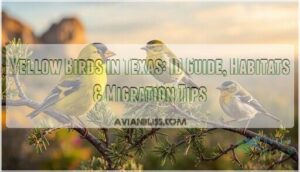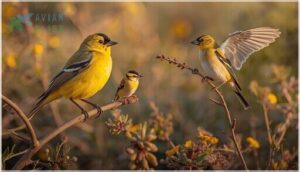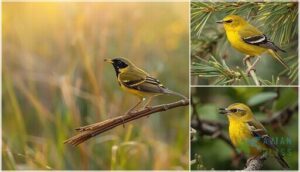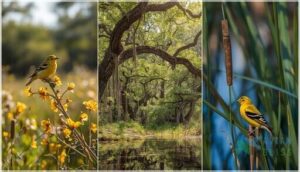This site is supported by our readers. We may earn a commission, at no cost to you, if you purchase through links.
A flash of bright yellow catches your eye as you step outside with your morning coffee—was that a goldfinch or one of those tricky warblers? Texas hosts over a dozen yellow bird species, and telling them apart isn’t always straightforward.
The American Goldfinch might visit your backyard feeder year-round, while the endangered Golden-cheeked Warbler only nests in specific Hill Country juniper-oak woodlands. Some yellow birds stick around all year, others pass through during spring and fall migrations, and a few show up only in summer to breed in riparian zones.
Learning to identify these species opens up a whole new dimension of birdwatching across Texas’s diverse landscapes.
Table Of Contents
- Key Takeaways
- Common Yellow Birds in Texas
- Distinctive Features and Identification
- Habitats of Yellow Birds Across Texas
- Migration Patterns and Seasonal Visitors
- Conservation and Birdwatching Tips
- Frequently Asked Questions (FAQs)
- How do I identify yellow birds in Texas?
- How many yellow birds are there in Texas?
- What birds are most common in Texas?
- What is the smallest yellow bird in Texas?
- How do you attract yellow birds in Texas?
- Is a goldfinch a yellow bird in Texas?
- What is the most common yellow bird?
- What is the yellow songbird in Texas?
- What does a female yellow warbler look like?
- How to identify yellow bird calls?
- Conclusion
Key Takeaways
- Texas hosts over a dozen yellow bird species with varying residency patterns—some like the American Goldfinch stay year-round, while others such as the Yellow Warbler pass through only during spring and fall migrations, making timing critical for successful identification.
- The endangered Golden-cheeked Warbler nests exclusively in Texas’s Hill Country juniper-oak woodlands, with only 4% of suitable habitat remaining protected despite conservation funding exceeding $1.8 million for species preservation efforts.
- Accurate identification requires observing multiple field marks beyond color—plumage patterns shift dramatically by season (goldfinches molt twice annually), and distinguishing features include wing bars, bill shapes, and unique markings like the Common Yellowthroat’s black facial mask.
- Texas funnels 98.5% of North America’s migratory birds through its Central and Mississippi Flyways, with peak warbler migration occurring late April through early May, though climate change now shifts arrival dates up to two weeks earlier than historical records.
Common Yellow Birds in Texas
Texas is home to some of the most vibrant yellow birds you’ll encounter anywhere in North America. From the cheerful American Goldfinch to the secretive Common Yellowthroat, each species brings its own personality and field marks to your backyard or favorite birding spot.
Here are six yellow birds you’re most likely to spot across the Lone Star State.
American Goldfinch
The American Goldfinch ranks among Texas’s most striking yellow birds, especially during winter when males flash bright yellow plumage with black wings and cap.
You’ll spot these energetic flyers in weedy fields and open floodplains statewide, peaking from October through April. Their goldfinch diet centers on seeds—think thistle and sunflower—while flock behavior keeps them moving together through native grasslands, foraging in synchronized waves.
To learn more about these birds, understanding their yellow bird habitats is essential for effective birdwatching.
Yellow Warbler
While goldfinches dominate winter flocks, Yellow Warblers bring summer energy to Texas’s riparian zones and thickets. You’ll catch their vibrant yellow feathers and sweet bird songs from mid-March through July as they establish nesting habits along watercourses. These warblers arrive during spring warbler migration, targeting brushy areas where their warbler diet of insects thrives. The Yellow-throated Warblers’ preferred breeding habitats play a vital role in their survival.
- Males display uniformly yellow plumage with subtle reddish breast streaking
- Spring arrival peaks from mid-March to late April across Texas
- Breeding season extends from late April through mid-July statewide
- Population trends show regional variation but no significant decline
- Important songbird species for birdwatchers during bird migration patterns
Pine Warbler
Unlike riparian-loving Yellow Warblers, Pine Warblers make their home in the pine forests of Texas’s Pineywoods and Post Oak Savannah. You’ll spot these yellow-bellied warblers nesting high in pine branches from late March through July, where they weave compact nests using pine needles and spider silk.
Their population’s grown by 3.5% annually since 1980—a win for bird conservation and Texas avifauna that shows habitat protection works.
Yellow-breasted Chat
You’ll hear the Yellow-breasted Chat before you see it—their bizarre song patterns include whistles, clucks, and cackles from dense thickets across Edwards Plateau and Pineywoods.
This largest warbler species arrives April through May, breeding in brushy riparian zones until August.
Their bright yellow plumage and bold personality make them standouts among Texas warblers, with populations growing 3.9% annually since 1980.
Lesser Goldfinch
You’ll spot this smaller cousin of the American Goldfinch mostly in western Texas, where they’ve carved out lightly wooded territories from March through July.
Their semi-colonial nesting habits and seed preferences make them locally abundant near flowering plants.
Watch for their distinctive black cap—it extends further down the nape than other yellow bird species, helping with bird identification during breeding seasons when Texas wildlife watching peaks.
Common Yellowthroat
This masked bandit of Texas marshes stands out with its distinctive black face stripe and bright yellow throat. During migration and winter, you’ll find Common Yellowthroats fairly common in southern Texas but rare in western regions:
- Population trends show -3.5% to +6.9% annual change (1966-2003)
- Breeding habitat conservation remains vital for population sustainability
- Nesting sites favor dense vegetation along water sources
- Migration routes bring waves of warblers through riparian zones
- Song recognition helps with bird identification in thick marshland cover
Distinctive Features and Identification
Spotting a flash of yellow in the Texas sky is one thing—but knowing exactly which bird you’re looking at? That’s where the real fun begins. You’ll need to pay attention to more than just color, since size, shape, and seasonal changes all play a role in accurate identification.
Let’s break down the key features that’ll help you tell one yellow bird from another.
Plumage Patterns and Coloration
Plumage variation among Texas’s yellow birds reveals striking diversity beyond simple yellow coloring. American Goldfinch males flash bright yellow with stark black wings, while Yellow Warblers show vivid yellow underparts with rusty streaks. Pine Warblers display olive-green backs with two white wing bars. These Molt Patterns shift seasonally—goldfinches transform from dull winter plumage to vibrant breeding colors through hormonal changes.
| Species | Male Breeding Colors | Distinctive Markings |
|---|---|---|
| American Goldfinch | Bright yellow body, black wings/tail | White undertail coverts, black forehead |
| Yellow Warbler | Vivid yellow, faint rusty breast streaks | Uniformly yellow appearance |
| Pine Warbler | Yellow throat/belly, olive-green back | Two prominent white wing bars |
| Lesser Goldfinch | Glossy black upper, bright yellow below | Yellow undertail coverts, white wing patches |
Color Genetics link plumage brightness to immune health—males with intense yellow coloring possess better immune function, making Feather Structure an honest indicator of fitness. Carotenoid pigments from their diet create these stunning yellows, connecting environmental quality directly to Bird Identification success. You’ll notice Common Yellowthroats sport bright yellow throats contrasted with black facial masks, while Yellow-breasted Chats display olive upperparts against their vibrant yellow breast.
Size and Shape Differences
Size variations among Yellow Birds in Texas range dramatically—you’ll find the Yellow-breasted Chat measuring 7.1 inches compared to the diminutive Lesser Goldfinch at just 4 inches.
Body proportions matter for identification: Warblers show compact builds with medium tail length, while Kingbirds display bulkier frames.
Bill shapes vary too—goldfinches sport conical seed-crushing bills, whereas Yellow Bird Species like warblers possess slender insect-catching beaks.
Wing span differences affect flight patterns noticeably.
Seasonal Plumage Changes
You’ll notice dramatic color shifts in Texas yellow birds throughout the year—molt patterns and hormonal influences drive these transformations. Understanding seasonal plumage adaptations improves bird identification markedly:
- American Goldfinches undergo complete feather replacement from September through November, then brighten again February to April for breeding plumage
- Yellow Warbler migration patterns align with color changes, showing richer tones during spring passage
- Males display more vibrant yellow bird plumage than females seasonally
- Winter months bring drab olive-brown tones for camouflage
Unique Markings by Species
You’ll find each Texas yellow bird carries its own signature mark—think of them as field badges. The Common Yellowthroat’s black mask stands out instantly, while wing bars help separate Pine Warblers from Yellow Warblers.
Beak shapes differ too: the Yellow-breasted Chat sports a thick, curved bill, contrasting with the fine, pointed bills of most warblers. Tail features and head markings complete the identification puzzle.
Habitats of Yellow Birds Across Texas
Where you find yellow birds in Texas depends entirely on the species you’re hoping to spot. Each habitat type—from dense forests to open grasslands—attracts different yellow-plumaged visitors with specific nesting and feeding needs.
Let’s break down the major ecosystems across the state and the yellow birds that call them home.
Piney Woods and Eastern Forests
You’ll find Eastern Texas’s Piney Woods sheltering the highest concentration of yellow birds in the state, with 353 documented species thriving in these dense pine and hardwood forests. Pine Warblers prefer mature pine stands here, while Yellow Warblers pass through during spring migration.
Forest ecology determines woodland bird species distribution, making woodland conservation vital for sustaining eastern habitats. Bird migration peaks from April to May in these protected Eastern Meadowlark territories.
Hill Country and Central Texas
Moving westward into Hill Country and Central Texas, you’ll discover the exclusive breeding territory of the Golden-cheeked Warbler—Texas’s only endemic nesting bird. This region’s mature Ashe juniper and oak woodlands create irreplaceable warbler habitats supporting roughly 233,000 males across 67,000 square kilometers.
Central ecosystems face mounting pressure from development, but conservation efforts protect critical sites:
- Balcones Canyonlands Preserve safeguards 33,000 acres
- 19 wildlife refuges support Texas migration routes
- Five Audubon societies promote birdwatching in Texas
- Protected areas rank No. 3 nationally for birding diversity
- 679 documented bird species showcase outstanding yellow birds variety
Bird conservation remains essential as habitat loss accelerates throughout this threatened landscape.
Prairies, Plains, and Grasslands
Texas’s open prairies and grasslands tell a harsher story. Lesser Goldfinch populations have plummeted 4.14% annually since 1966, while overall grassland birds declined 34% between 1970 and 2022.
You’ll still spot Lesser Goldfinches year-round across the Edwards Plateau—breeding among sunflowers where rainfall stays below 90 cm—but habitat restoration and prairie conservation efforts can’t come fast enough for these struggling ecosystem survivors.
Riparian Zones and Wetlands
While grasslands struggle, riparian zones and wetlands remain biodiversity hotspots you can’t overlook. Texas’s 3.9 million wetland acres support 58 bird species—including Yellow Warblers and Common Yellowthroats—far exceeding upland diversity.
These corridors deliver ecosystem services you depend on:
- Water quality filtration through vegetation
- Flood storage and aquifer recharge
- Critical habitat for breeding warblers
- Nutrient trapping from surface runoff
- Pollutant breakdown before downstream flow
Yet habitat restoration can’t keep pace with 52% historical wetland loss.
Migration Patterns and Seasonal Visitors
Texas sits right in the middle of major flyways, which means the yellow birds you spot in spring might vanish by summer. Some species stick around all year, while others just pass through on epic journeys between continents.
Understanding who’s visiting when will completely change how you time your birdwatching trips.
Spring and Fall Migratory Species
When millions of migrating birds funnel through Texas each spring and fall, yellow warblers steal the show. You’ll spot Yellow-rumped Warblers, Northern Parulas, and Magnolia Warblers from March through May, then again from late September to November.
Texas sits at the crossroads of the Central and Mississippi Flyways, making it essential for avian migration patterns and flyway conservation efforts nationwide.
Year-Round Residents Vs. Seasonal Visitors
Roughly half the yellow birds you’ll find in Texas stick around all year, while the rest just pass through. American Goldfinches and Lesser Goldfinches maintain resident patterns across various habitats, favoring open areas with abundant seeds.
Meanwhile, most Yellow Warblers treat Texas as a pit stop during migration routes spanning March to May. These seasonal shifts reveal distinct habitat preferences and population dynamics that shape Texas bird migration patterns throughout the year.
Notable Migratory Routes in Texas
At the crossroads of the Central and Mississippi Flyways, Texas channels 333 of North America’s 338 migratory species—a staggering 98.5% of avian migration. Southeast corridors like Harris County register over 112 million birds during fall migration patterns, with warblers and other yellow species following Texas corridors protected under the Migratory Bird Treaty Act.
Texas funnels 98.5% of North America’s migratory birds through its flyways, with over 112 million passing through Harris County alone each fall
Bird tracking reveals that flyway conservation efforts now monitor 1.25 billion birds crossing nightly during peak seasons.
Timing of Key Migrations
You’ll catch peak warbler action in late April through early May, when Texas hosts its most dramatic migration surges. Climate Impact now shifts Arrival Dates up to two weeks earlier than 1980s records, compressing traditional migration windows.
Key Migration Patterns for Yellow Birds:
- American Goldfinches winter December–March, departing by September
- Yellow Warblers pass through late March–May and mid-August–October
- Common Yellowthroats peak early April arrivals, depart by late October
- Seasonal Shifts cause drought-shortened stopovers
- Departure Windows for warblers begin as early as August
Conservation and Birdwatching Tips
Protecting Texas’s yellow birds means understanding which species need our help most and how you can make a real difference. Whether you’re tracking rare warblers in the Hill Country or setting up your own backyard haven, knowing where to look and what these birds need will shape your success.
Let’s explore the conservation challenges these species face and the practical steps you can take to support them.
Threatened and Endangered Yellow Birds
You’ll find the Golden-cheeked Warbler stands as Texas’s most critically endangered yellow bird, federally listed since 1990 as habitat loss and fragmentation devastate its Central Texas breeding grounds. This warbler nests exclusively within the state, making species protection urgent.
Conservation efforts focus on habitat preservation through land acquisition and cowbird control programs, though urban sprawl continues threatening juniper-oak woodlands essential for these warblers and other yellow birds during migration.
Best Locations for Birdwatching
You’ll discover Texas’s leading yellow bird hotspots along the Gulf Coast, where High Island records over 230 species annually during migration. These Birding Trails and Coastal Refuges offer unequalled access to yellow warblers and chats as they navigate major flyways:
- The Rio Grande Valley’s World Birding Center spans 9 sites supporting approximately 500 bird species
- Anahuac National Wildlife Refuge attracts 200+ migratory species with essential stopover bird habitats in Texas
- The Piney Woods region hosts 10-30 Yellow-breasted Chats per survey route statewide
- Peak birdwatching runs early April through late May and late July to mid-October
Attracting Yellow Birds to Your Backyard
After scouting those prime birdwatching locations, you can bring yellow birds right to your own backyard with strategic planning. Install feeders stocked with black oil sunflower and nyjer seeds near protective vegetation, as American Goldfinches prefer hopper and platform types.
Plant bird-friendly plants like native milkweed, thistles, and coneflowers that provide natural seed sources.
Add water features and maintain clean feeders to support these yellow-feathered bird species throughout their seasonal visits across diverse bird habitats in Texas.
Habitat Preservation Efforts in Texas
Beyond backyard efforts, you’re part of a bigger movement. Texas has secured over $1.8 million in conservation funding for habitat restoration and avian ecology projects.
Wildlife protection initiatives focus on endangered species like the golden-cheeked warbler, where only 4% of suitable habitat remains protected.
These biodiversity conservation and nature preservation efforts deliver ecosystem services while safeguarding environmental conservation for future generations.
Frequently Asked Questions (FAQs)
How do I identify yellow birds in Texas?
You’ll notice Texas bird species reveal their identities through distinctive beak shapes, wing patterns, and feather textures.
Listen for unique bird songs, observe tail lengths, and compare yellow feathered bird species’ seasonal plumage variations.
How many yellow birds are there in Texas?
Texas hosts at least 29 distinct yellow bird species, making up roughly 4% of the state’s 664 recorded avian species. You’ll find warblers, goldfinches, and orioles among these colorful residents and seasonal migrants.
What birds are most common in Texas?
You’ll spot Northern Cardinals, Blue Jays, and Mourning Doves practically everywhere—they dominate feeders and backyards statewide.
But during migration, warblers flood through by the millions, turning Texas into one of North America’s busiest avian highways.
What is the smallest yellow bird in Texas?
You’ll spot the Lesser Goldfinch as Texas’s tiniest yellow bird, measuring just 5 to 3 inches long and weighing barely 6 to 5 grams—perfect for nimble seed-cracking at your backyard feeders.
How do you attract yellow birds in Texas?
You’ll draw goldfinches and warblers by offering Nyjer and sunflower seed in clean bird feeders, adding fresh water sources, and planting native Texas asters and coneflowers that boost yellow bird populations during migration seasons.
Is a goldfinch a yellow bird in Texas?
Yes, the American Goldfinch absolutely qualifies as a Yellow Bird in Texas. You’ll recognize males by their bright canary-yellow plumage during breeding season, making them unmistakable at feeders statewide.
What is the most common yellow bird?
The American Goldfinch ranks as the most frequently observed yellow feathered bird in Texas avifauna, appearing on 19% of winter bird sightings.
Yellow Warblers and orioles also contribute notably to regional feather patterns.
What is the yellow songbird in Texas?
The American Goldfinch leads Texas avifauna with striking yellow plumage and year-round presence. Lesser Goldfinches and various warblers complete the songbird identification roster.
Though species conservation efforts remain critical for yellow feathered birds, they face habitat loss.
What does a female yellow warbler look like?
You’ll recognize a female Yellow Warbler by her soft yellow body and olive-greenish back. Unlike males, she lacks bold breast streaks—just faint markings and a plain yellow face with dark eyes.
How to identify yellow bird calls?
Listen for distinctive vocal cues like the American Goldfinch’s “potato-chip” call or Yellow Warbler’s sweet whistles.
Acoustic software and frequency analysis help ornithology enthusiasts master birdsong recognition for accurate warblers and yellow birds identification in the field.
Conclusion
Think of learning about yellow birds in Texas like tuning a radio—suddenly, signals you once missed come through crystal clear. That flash of gold might be a migrating warbler following ancient flyways or a goldfinch claiming your backyard as home ground.
Once you know what to watch for, those fleeting moments transform into reliable encounters. You’re not just spotting birds anymore—you’re reading the landscape, tracking seasons, and joining something bigger than any single sighting.
- https://en.wikipedia.org/wiki/Migratory_Bird_Treaty_Act_of_1918
- https://a-z-animals.com/animals/birds/bird-facts/yellow-birds/
- https://txtbba.tamu.edu/species-accounts/yellow-warbler/
- https://travisaudubon.org/murmurations/texas-judge-upholds-endangered-species-act-protections-for-golden-cheeked-warbler
- https://birdwatchinghq.com/yellow-birds-in-texas/











